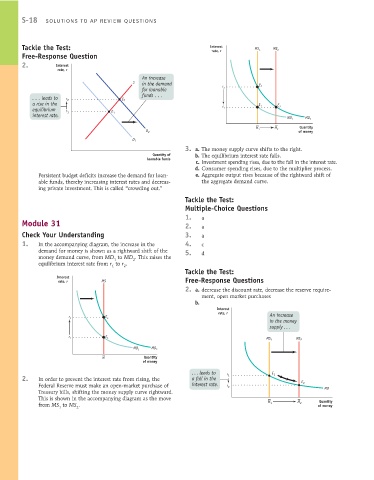Page 864 - Krugmans Economics for AP Text Book_Neat
P. 864
S-18 SOLUTIONS TO AP REVIEW QUESTIONS
Tackle the Test: Interest MS 1 MS 2
rate, r
Free-Response Question
2. Interest
rate, r
An increase
S in the demand
r 2 E 2
for loanable
funds . . .
. . . leads to r 2 E 2
a rise in the E 1 E 3
r 1
equilibrium r 1 E 1
interest rate.
MD 1 MD 2
Quantity
M 1 M 2
D 2 of money
D 1
3. a. The money supply curve shifts to the right.
Quantity of b. The equilibrium interest rate falls.
loanable funds
c. Investment spending rises, due to the fall in the interest rate.
d. Consumer spending rises, due to the multiplier process.
Persistent budget deficits increase the demand for loan- e. Aggregate output rises because of the rightward shift of
able funds, thereby increasing interest rates and decreas- the aggregate demand curve.
ing private investment. This is called “crowding out.”
Tackle the Test:
Multiple-Choice Questions
1. a
Module 31 2. a
Check Your Understanding 3. a
1. In the accompanying diagram, the increase in the 4. c
demand for money is shown as a rightward shift of the 5. d
money demand curve, from MD to MD . This raises the
1
2
equilibrium interest rate from r to r .
1 2
Tackle the Test:
Interest
rate, r MS Free-Response Questions
2. a. decrease the discount rate, decrease the reserve require-
ment, open market purchases
b.
Interest
rate, r An increase
r 2 E 2
in the money
supply . . .
r 1 E 1
MS 1 MS 2
MD 1 MD 2
M Quantity
of money
. . . leads to r E 1
2. In order to prevent the interest rate from rising, the a fall in the 1
Federal Reserve must make an open-market purchase of interest rate. r 2 E 2
MD
Treasury bills, shifting the money supply curve rightward.
This is shown in the accompanying diagram as the move Quantity
from MS to MS . M 1 M 2 of money
2
1

